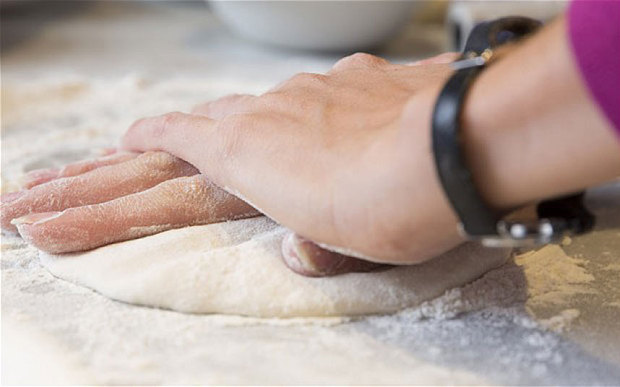
From http://www.telegraph.co.uk/foodanddrink/recipes/10638854/Pizza-recipes-the-perfect-dough.html
Takes about 16-18 hours. You can also make the dough in the morning for use in the evening by adding 20 per cent more yeast.
Makes approximately 640g of dough which should be enough for 2 or 3 pizzas
Ingredients
- 250ml lukewarm (22C) water
- 0.2g dry yeast
- 1 dessertspoon olive oil
- 380g flour
- 10g salt
Method
- In a bowl or jug, measure out the water and add the yeast (or sourdough starter). Stir or whisk in, then add the olive oil.
- Place the flour and salt in a large, two-litre ceramic bowl and combine the ingredients with your fingertips.
- Pour the liquid into the flour in a few stages, mixing each time with stiff fingers.
- Work lightly, using only your fingers to draw the dough together and mop up all the flour. Avoid getting dough on the palm of your hand. Knead the dough a little with your knuckles.
- Once the ingredients have roughly combined you can rest the dough. This will make it easier to knead.
- After 15 minutes, use your fingers and knuckles to knead the dough for about five minutes.
- Once kneaded, cover the bowl with cling film or a damp cloth and leave the dough to sit for one hour.
- With a lightly oiled hand this time, fold the dough by drawing the four edges consecutively into the centre, and then pressing down on them. With the shape of your hands, form a large ball and then turn the mass over. Brush a bit more olive oil on top and cover the bowl again to store, making sure it’s airtight.
- Leave the dough in an ambient temperature of 20C-23C and in 16-18 hours, your dough will be ready to use. If the temperature is colder (15C-18C) it will take a little longer.
Shaping Balls
The baked and fried pizzas both start with a ball of dough that is opened (stretched) into shape. For pan baking, 160g balls will fit easily into the base of an iron pan. For pizzette (small, fried pizzas), cut the dough into 50g balls.
Tip the dough onto a floured surface and divide the developed dough mass into equal pieces with a dough cutter. Our dough recipe makes 640g, so that means dividing it by four. Alternatively, you can weigh balls on a set of scales.
Knock back the dough pieces by rolling them in a circle on a table until they form tight balls. When you do this, keep a tight grip around the edges of the ball with your fingertips while applying some pressure from the palm of your hand on top. You may want to practice, but do not overdo the shaping of each ball, as you will tear the dough.
Place these on a floured surface in an airtight container or in a deep baking tray. If using a tray, drape a dampened tea towel over it, but be sure to tuck the edges of the cloth under the tray, so the rising dough does not stick to the sagging cloth. At normal temperatures (18C) these dough balls will take up to two hours to prove. In a warm kitchen (24C), one hour will be enough.